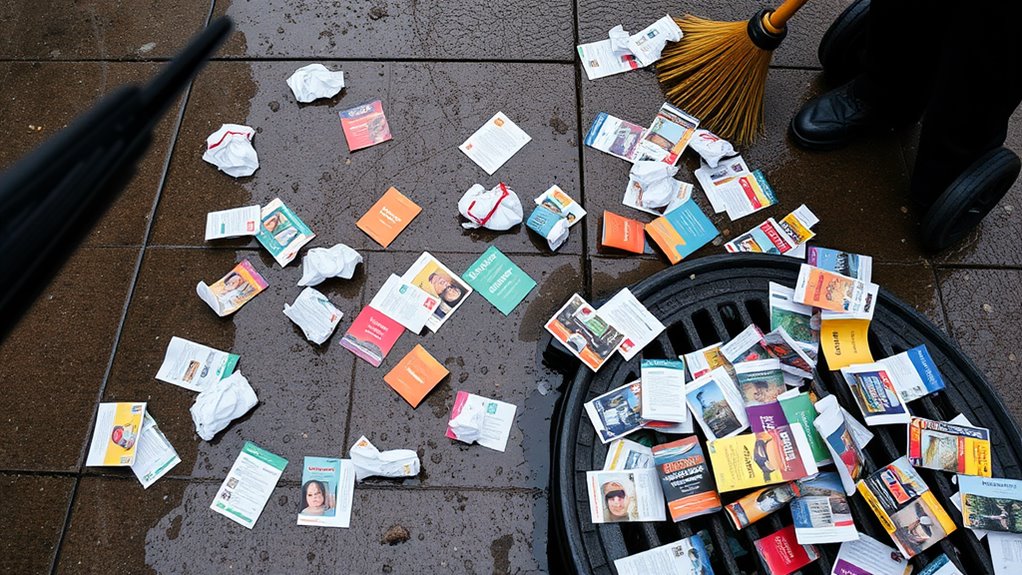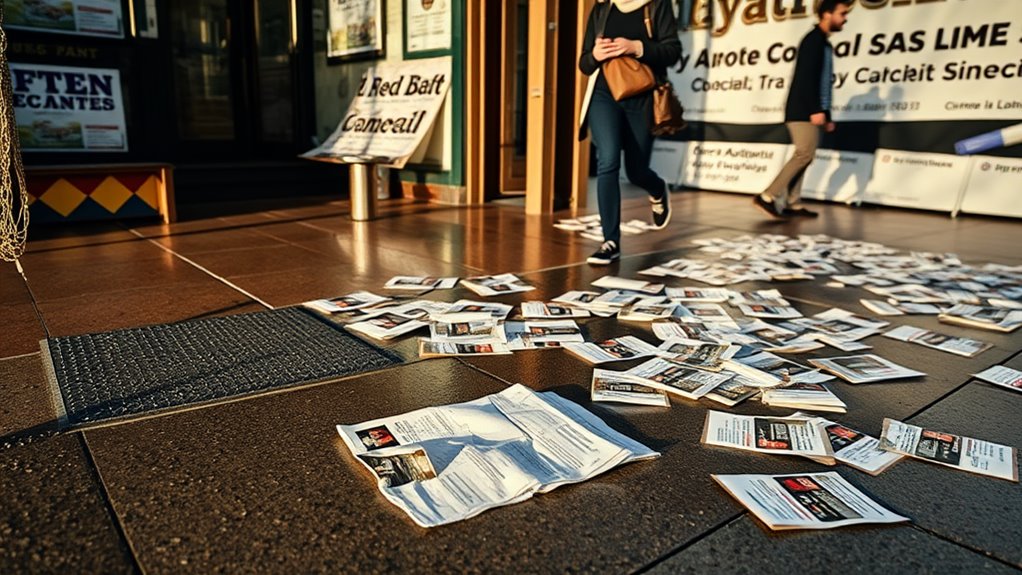Flyers come with several significant drawbacks that can impact your marketing effectiveness. You'll face challenges tracking actual readership and ROI, with studies showing up to 44% of flyers are discarded unread. Distribution costs add up quickly, ranging from $0.10 to $0.25 per flyer plus labor expenses of $12-$15 per hour for distribution. Environmental concerns are substantial, as each ton of paper requires approximately 17 trees. You're also competing in an oversaturated market, where consumers encounter 15-20 promotional materials daily and have declining attention spans of just 8 seconds. Understanding these limitations can help you develop more effective marketing strategies.
Key Takeaway
- Difficult to measure effectiveness as tracking actual readership and linking flyer campaigns to sales remains largely unreliable.
- High production and distribution costs, including printing expenses between $0.10-$0.25 per flyer and labor costs of $12-$15 hourly.
- Poor targeting capabilities make it challenging to reach specific demographics, with limited feedback mechanisms to gauge audience interest.
- Marketing oversaturation means flyers compete with 15-20 daily promotional materials, resulting in 60% being discarded without reading.
- Significant environmental impact through paper waste, with up to 44% of flyers discarded unread and production requiring substantial tree resources.
Limited Digital Integration
Digital connectivity presents a significant barrier for traditional flyers in today's tech-driven world. You'll find that paper flyers can't seamlessly integrate with your digital marketing ecosystem, limiting their effectiveness in modern campaigns.
Key Digital Limitations:
- You can't track real-time engagement metrics
- There's no ability to update content once printed
- You can't directly link to your website or social media
- Audience targeting remains imprecise compared to digital alternatives
While your digital ads can instantly connect viewers to purchase pages, flyers require manual action from your audience. Consider that 73% of consumers now expect omnichannel marketing experiences, but flyers exist outside this digital framework.
Practical Impact on Your Marketing:
- You're missing valuable analytics data
- Your ROI tracking becomes challenging
- Cross-platform integration isn't possible
- You can't implement A/B testing effectively
To overcome these limitations, you'll need to create hybrid solutions, such as adding QR codes or NFC tags to your flyers. However, this workaround still doesn't fully bridge the digital divide, and you'll continue facing connectivity constraints that digital-native advertising doesn't experience.
High Distribution Costs
- Printing costs: You're looking at $0.10-0.25 per flyer for quality color prints, which can reach thousands of dollars for large campaigns
- Distribution labor: You'll typically pay $12-15 per hour per worker, with most distributors covering 150-200 houses per hour
- Transportation expenses: Fuel, vehicle maintenance, and insurance costs for your distribution team
- Wasted materials: You'll lose 15-20% of flyers to weather damage, improper handling, or disposal
To maximize your investment, you'll need to:
- Plan strategic distribution routes to minimize transportation costs
- Bundle printing orders for bulk discounts
- Hire reliable distributors to guarantee proper delivery
- Track distribution efficiency through GPS monitoring
- Implement quality control measures to reduce waste
Even with careful planning, you're still facing higher costs per impression compared to digital alternatives, which often start at just pennies per view.
Environmental Impact
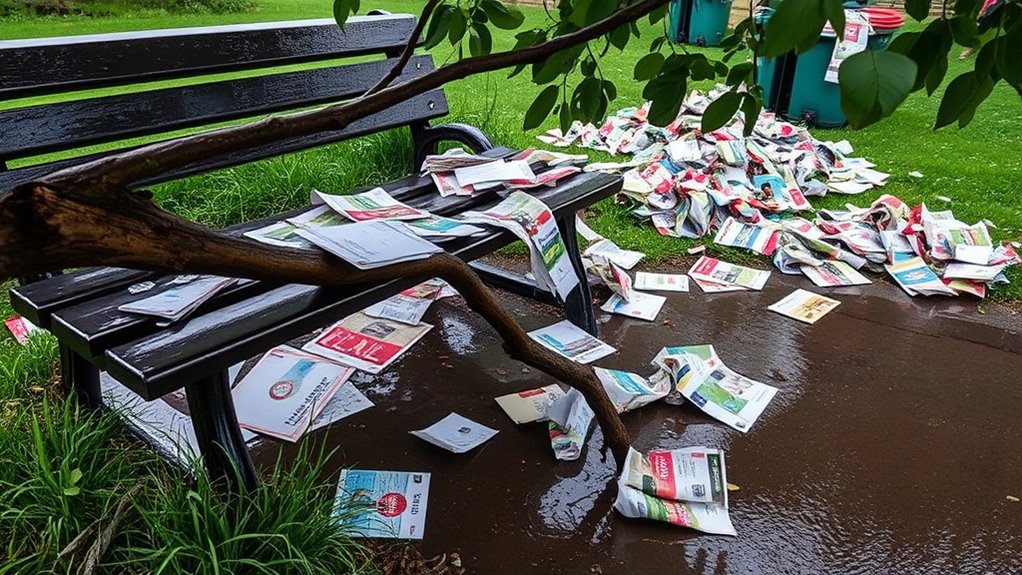
The environmental footprint of flyer marketing raises significant concerns for businesses aiming to maintain sustainable practices. When you distribute paper flyers, you're contributing to several ecological challenges that impact our planet's health.
Environmental Consequences
- You'll generate substantial paper waste, as studies show up to 44% of flyers end up in the trash without being read
- Your flyer campaigns contribute to deforestation, with each ton of paper requiring approximately 17 trees
- You're increasing your carbon footprint through the printing process, which uses energy and chemical-based inks
- Your distribution methods often rely on fuel-consuming vehicles, adding to greenhouse gas emissions
- You'll create additional waste through the disposal of unused or outdated promotional materials
To minimize these impacts, you can consider digital alternatives or eco-friendly printing options. When you must use traditional flyers, select recycled paper and vegetable-based inks to reduce your environmental impact. Many modern consumers will appreciate your effort to balance marketing needs with environmental responsibility, as 73% of millennials are willing to spend more on sustainably produced materials.
Brief Consumer Attention Span
Modern consumers' rapidly shrinking attention spans pose a significant challenge for flyer marketing effectiveness. You'll find that most recipients spend less than 3 seconds scanning a flyer before deciding whether to keep or discard it, making your message's impact window extremely brief.
Key Attention Span Challenges:
- Studies show the average person's attention span has dropped to just 8 seconds, compared to 12 seconds in 2000
- You're competing with multiple digital distractions that can pull focus away from print materials
- Your target audience processes around 5,000 marketing messages daily, making standout difficult
How Brief Attention Affects Your Flyer's Performance:
- Your headline has only 1-2 seconds to capture interest
- Complex information often gets overlooked or misunderstood
- Multiple messages on one flyer typically result in reduced comprehension
To combat these limitations, you'll need to:
- Focus on single, clear calls-to-action
- Use bullet points and short paragraphs
- Incorporate eye-catching visual elements strategically
- Limit text to essential information only
Oversaturated Marketing Medium
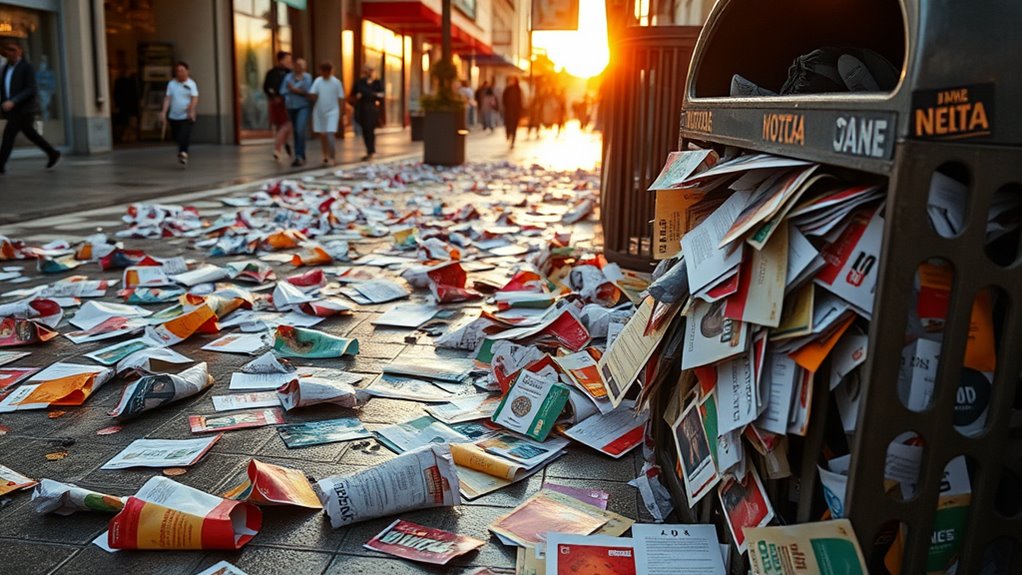
Beyond attention span challenges, flyer marketing faces another significant hurdle: market oversaturation. When you distribute flyers today, you're competing with countless other businesses doing exactly the same thing, making it increasingly difficult to stand out in the crowd.
Consider these common scenarios that illustrate market oversaturation:
- You'll find mailboxes stuffed with 15-20 promotional materials daily, causing your flyer to get lost in the shuffle
- Your target audience encounters an average of 50-75 street promoters distributing flyers during their weekly commute
- Local businesses typically see 60% of their flyers immediately discarded without being read
- Shopping centers and community bulletin boards display hundreds of overlapping advertisements
- Digital alternatives have made traditional flyers seem outdated, with 72% of consumers preferring electronic communications
To break through this clutter, you'll need to invest more resources in distinctive designs and premium printing, which drives up your marketing costs. The oversaturated market has transformed flyer marketing from a cost-effective solution into an increasingly expensive gamble, where standing out requires significant creative and financial investment.
Weather and Physical Damage
Physical elements pose constant threats to flyer marketing campaigns, with weather conditions and environmental factors being primary culprits in diminishing their effectiveness. When you distribute outdoor flyers, you'll face numerous environmental challenges that can quickly deteriorate your marketing materials.
Key Environmental Threats:
- Rain and moisture can turn your flyers into soggy, unreadable messes within hours
- Strong winds can tear flyers from posting locations or scatter them as litter
- Direct sunlight causes color fading and paper degradation within 3-5 days
- Temperature fluctuations lead to curling and warping of paper materials
Physical Damage Concerns:
- Vandalism and intentional removal by competitors or property owners
- Wear and tear from foot traffic when placed in high-traffic areas
- Animal interference, particularly in outdoor settings
- Accidental damage during distribution or posting
To mitigate these issues, you'll need to:
- Use weather-resistant paper (increases costs by 30-40%)
- Apply protective coatings or lamination
- Implement strategic placement techniques
- Schedule regular maintenance checks
- Plan for frequent replacement of damaged materials
These environmental challenges often result in significant waste and require additional budget allocation for replacements, impacting your campaign's overall ROI.
Tracking ROI Challenges
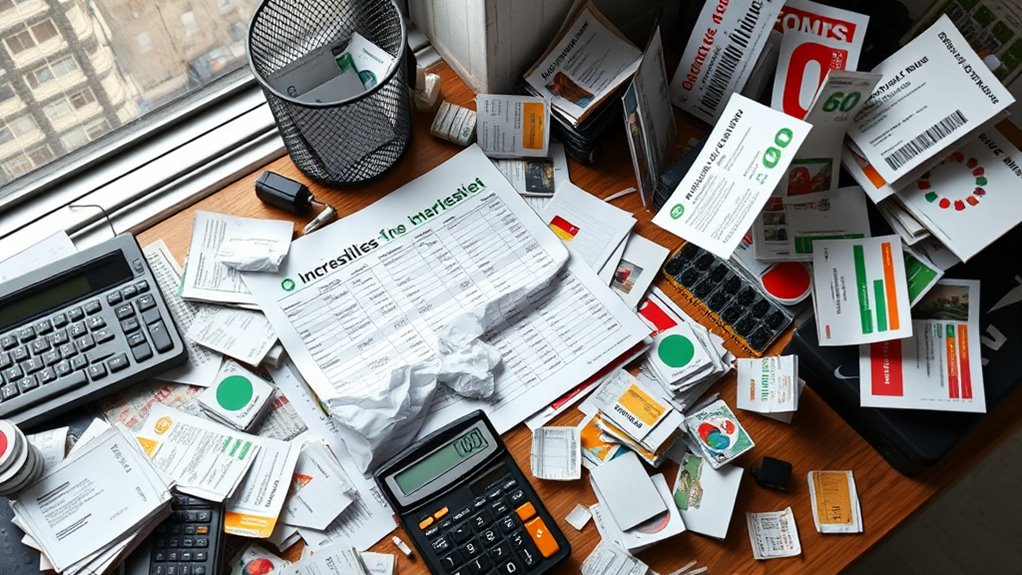
Marketing managers face persistent difficulties when measuring the return on investment for flyer campaigns. You'll encounter several roadblocks when trying to determine if your flyer distribution efforts are delivering worthwhile results, especially compared to digital marketing's precise analytics.
Key Tracking Challenges You'll Face:
- You can't accurately measure how many people actually read your flyers versus immediately discarding them, unlike email open rates or website click-through tracking
- There's no reliable way to connect in-store purchases directly to your flyer campaign without implementing complex coupon systems
- You'll struggle to gather demographic data about who's responding to your flyers, making audience targeting improvements difficult
- Traditional attribution methods don't work well since you can't track the customer journey from flyer exposure to purchase
- Your cost-per-acquisition calculations remain incomplete due to distribution variables and indirect response patterns
To overcome these challenges, you'll need to implement specialized tracking mechanisms like unique QR codes, dedicated landing pages, or exclusive promotional codes. Even then, you're likely capturing only a fraction of your campaign's true impact, making ROI calculations inherently imprecise compared to digital marketing metrics.
Conclusion
Like a paper boat in a digital ocean, flyers face significant challenges in today's marketing landscape. You'll need to weigh these disadvantages carefully before investing in flyer marketing – from their environmental footprint to rising distribution costs. If you're considering flyers for your campaign, remember that while they can still have their place, you'll likely want to combine them with digital strategies for better results and measurable outcomes.

